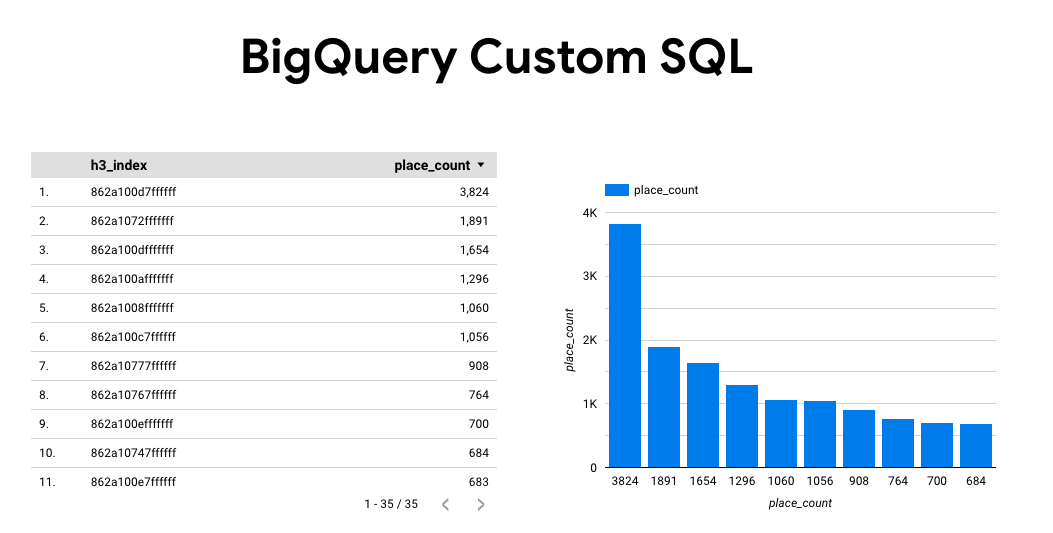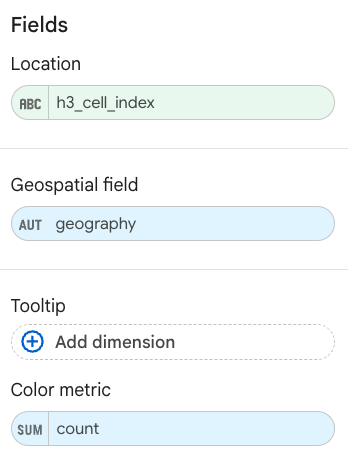PLACES_COUNT_PER_H3 işlevi, aranacak bir coğrafi alan alır ve arama alanındaki H3 hücresi başına yer sayısı tablosunu döndürür.
PLACES_COUNT_PER_GEO işlevi tablo döndürdüğünden, FROM yan tümcesi kullanarak çağırın.
Giriş parametreleri:
Zorunlu: Arama alanını belirten
geographyfiltre parametresi.geographyparametresi, noktaları, LineString'leri ve poligonları destekleyen BigQueryGEOGRAPHYveri türü tarafından tanımlanan bir değerdir.Farklı arama coğrafyası türlerini (ör. görünüm alanları ve çizgiler) kullanma örnekleri için
PLACES_COUNTişlevine bakın.Zorunlu: Her bir H3 hücresindeki yer sayısını toplamak için kullanılan H3 çözünürlüğünü belirten
h3_resolutionfiltre parametresi. Desteklenen değerler 0 ile 8 arasındadır.İsteğe bağlı: Aramanızı daraltmak için ek filtre parametreleri.
Şunu döndürür:
- H3 hücresi başına bir satır içeren bir tablo. Tabloda, H3 hücresini temsil eden poligonu tanımlayan
h3_cell_index(STRING),geography(GEOGRAPHY),count(INT64) veplace_ids(ARRAY<STRING>) sütunları bulunur.place_ids, her H3 hücresi için 250'ye kadar yer kimliği içerir.
- H3 hücresi başına bir satır içeren bir tablo. Tabloda, H3 hücresini temsil eden poligonu tanımlayan
Örnek: H3 hücresi başına tekerlekli sandalyeye uygun market ve bakkal sayısını hesaplama
Aşağıdaki örnekte, New York City'deki H3 hücresi başına tekerlekli sandalye erişimine uygun, hizmet veren ve market olan mağazaların sayısı hesaplanmaktadır. H3 hücreleri 8 çözünürlük seviyesini kullanır.
Bu örnekte, New York City'nin coğrafyasını almak için Overture Maps Data BigQuery herkese açık veri kümesi kullanılır.
DECLARE geo GEOGRAPHY; -- Get the geography for New York City. SET geo = (SELECT geometry FROM `bigquery-public-data.overture_maps.division_area` WHERE country = 'US' AND names.primary = 'City of New York' LIMIT 1); SELECT * FROM `PROJECT_NAME.places_insights___us.PLACES_COUNT_PER_H3`( JSON_OBJECT( 'geography', geo, 'types', ["convenience_store","grocery_store"], 'wheelchair_accessible_entrance', true, 'business_status', ['OPERATIONAL'], 'h3_resolution', 8 ) );
İşlevin yanıtı:

Sonuçları görselleştirme
Aşağıdaki resimlerde bu verilerin Looker Studio'da dolu harita olarak gösterildiği görülmektedir. H3 hücresi ne kadar koyu olursa sonuçların yoğunluğu o kadar yüksek olur:

Verilerinizi Looker Studio'ya aktarmak için:
Sonuçları oluşturmak için yukarıdaki işlevi çalıştırın.
BigQuery sonuçlarında Open in -> Looker Studio'yu (Şurada aç: Looker Studio) tıklayın. Sonuçlarınız otomatik olarak Looker Studio'ya aktarılır.
Looker Studio, varsayılan bir rapor sayfası oluşturur ve bu sayfayı sonuçların başlığı, tablosu ve çubuk grafiğiyle başlatır.

Sayfadaki her şeyi seçip silin.
Raporunuza dolu harita eklemek için Ekle -> Dolu harita'yı tıklayın.
Grafik türleri -> Kurulum bölümünde alanları aşağıda gösterildiği gibi yapılandırın:

Doldurulmuş harita yukarıdaki gibi görünür. Haritanın görünümünü daha da yapılandırmak için isteğe bağlı olarak Grafik türleri -> Stiller'i seçebilirsiniz.
Yer İşletmeleri Analizleri sonuçlarını görselleştirme hakkında daha fazla bilgi ve örnek için Sorgu sonuçlarını görselleştirme başlıklı makaleyi inceleyin.

